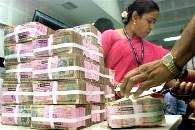 Given the tight control on expenditure the finance minister has exercised and how niggardly the increases have been on flagship programmes - Bharat Nirman has risen from Rs 32,473 crore (Rs 324.73 billion) to Rs 35,953 crore (Rs 359.53 billion) and employment guarantee from Rs 39,100 crore (Rs 391 billion) to Rs 40,100 crore (Rs 401 billion) - it's natural to wonder whether the deficit reduction targets are for real.
Given the tight control on expenditure the finance minister has exercised and how niggardly the increases have been on flagship programmes - Bharat Nirman has risen from Rs 32,473 crore (Rs 324.73 billion) to Rs 35,953 crore (Rs 359.53 billion) and employment guarantee from Rs 39,100 crore (Rs 391 billion) to Rs 40,100 crore (Rs 401 billion) - it's natural to wonder whether the deficit reduction targets are for real.
Clearly, there is much that can go wrong if global prices go up. The natural targets for this are petroleum prices where the government has not been able to take a decision for several years now - the Rs 3,108 crore (Rs 31.08 billion) kept aside here will end up being woefully low if crude prices rise above $75-80 a barrel.
Ditto for fertiliser subsidies. The other imponderables are food subsidies where the Right to Food Bill, when it is finally passed, could end up bloating subsidies, especially since there are three to four estimates on how many poor people India has and the difference between the top and the bottom is around 2.5 times.
Estimates for the size of the Right to Education Bill, passed in an earlier session of Parliament, also vary significantly, from around Rs 160,000 crore (Rs 1600 billion) over five years by the Planning Commission to around Rs 53,000 crore (Rs 530 billion) per year by others.
No finance minister worth his salt, though, leaves the downsides fully uncovered, certainly not one as shrewd as Pranab Mukherjee. Which is why, this time around, when the 3G auctions never fetched the anticipated Rs 35,000 crore (Rs 350 billion), Mukherjee didn't worry too much since he had an extra Rs 23,000 crore (Rs 230 billion) coming in from selling off shares of government-owned enterprises.
So, what are his upsides? For one, most believe the revenue collections from service tax are hugely understated since just a few of the services included - railways, aviation, coaching and health checkups - should ensure the finance minister more than meets his target. Indeed, the larger question of revenue buoyancy is the really critical one.
Mukherjee expects taxes to rise 18 per cent while nominal GDP rises 12.3 per cent, which implies a tax buoyancy of 1.5. It is true buoyancy rises sharply as an economy moves into an upcycle - buoyancy fell from 1.2 in 1993-97 to 0.9 in 1997-2003 when GDP growth fell from 6.8 per cent to 5.2 per cent, but rose to 1.6 as GDP growth rose to 8.9 per cent in the 2003-08 period. But this needs to be interpreted with some degree of caution.
Excise duty collections, from where extra Rs 30,000 crore (Rs 300 billion) is to come, have not grown in line with industrial growth in the past, and customs buoyancy (an equal amount is to come from here) really depends upon how global trade fares, and there is a question mark over how robust trade flows will be.
If the recovery is not very robust, as the Economic Survey points out, the revenue optimism may turn out to be misplaced.
The same goes for the Rs 40,000 crore target for disinvestment if the markets are downcast or don't believe the government is serious about reforms. And the 3G auction, past experience tells us, isn't done till it's done! Don't bet on the fiscal target being met.








